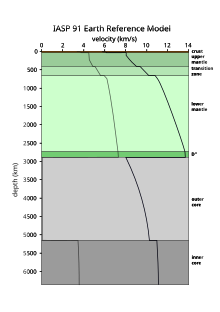Jacket transition zone

The mantle transition zone is geophysically defined by significant jumps in speed of seismic waves and lies on average between 410 and 660 km depth. The transition zone is characterized by an increase in density from 3.42 g / cm³ in the lowest upper mantle to 3.9 g / cm³ in the uppermost lower mantle .
Phase transitions
The changes in wave speeds can today be traced back to essentially three phase transitions of certain minerals (the depth data are global mean values):
- the olivine, which is stable in the upper mantle, goes into wadsleyite and later from a depth of 410 km
- from a depth of approx. 520 km in ringwoodite .
- The lower edge of the transition zone is the phase transition from ringwoodite to magnesium perovskite and magnesiowustite at an average depth of 660 km .
Significance for geodynamics
Due to the phase transitions and the denser rocks that occur here, the mantle transition zone initially represents an obstacle to further subduction and thus full mantle convection . According to more recent findings, however, a submergence of the plate remains to the core-mantle boundary seems very likely.
According to a study, there could also be partial melting and / or drainage of the former oceanic crust in the transition zone , which could result in mantle diapirs . Inclusions of majorite in diamonds prove that rocks originate at least from the mantle transition zone.
swell
- P. Kearey (2008): Global Tectonics. 3rd edition. P. 32f
- T. Stachel: Inclusions in diamonds - "boreholes" in the deep mantle of the earth. http://www.uibk.ac.at/mineralogie/oemg/bd_145/145_031-037.pdf
- Dapeng Zhao: Global tomographic images of mantle plumes and subducting slabs: insight into deep Earth dynamics, Physics of the Earth and Planetary Interiors, Volume 146, Issues 1–2, August 16, 2004, Pages 3-34, ISSN 0031-9201 , doi : 10.1016 / j.pepi.2003.07.032 . ( http://www.sciencedirect.com/science/article/pii/S0031920104001086 )
Individual evidence
- ↑ http://www.nature.com/ngeo/journal/v6/n5/pdf/ngeo1772.pdf
- ↑ M. Okrusch (2011): Mineralogy - An introduction to special mineralogy, petrology and deposit science. 8th edition p. 490f